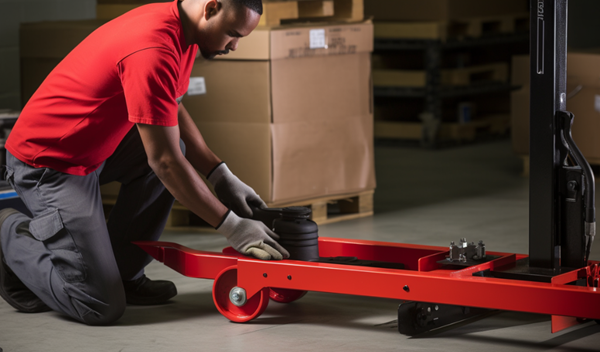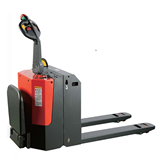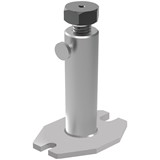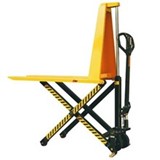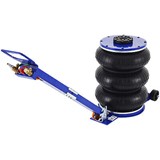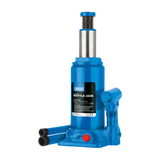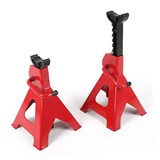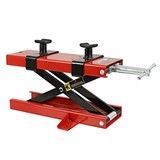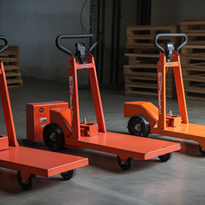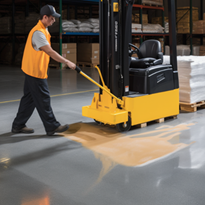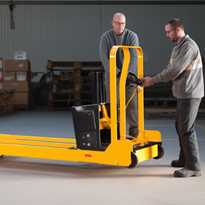Hand pallet jacks are essential tools in material handling operations, and proper maintenance and repairs are vital to ensure their longevity and optimal performance. By implementing regular maintenance practices and promptly addressing any repairs or issues, you can maximize the lifespan of your hand pallet jack and ensure safe and efficient operations. In this article, we will explore some important maintenance and repair guidelines for hand pallet jacks.
Routine Maintenance Tasks for Hand Pallet Jacks: Keeping Your Equipment in Top Shape
Routine maintenance is essential to ensure the longevity, safety, and optimal performance of your hand pallet jack. By implementing regular maintenance tasks, you can prevent costly repairs, minimize downtime, and extend the lifespan of your equipment. In this article, we will explore some key routine maintenance tasks that should be performed on hand pallet jacks.
1. Cleaning
Regular cleaning is vital to keep your hand pallet jack free from dirt, debris, and other contaminants that can affect its performance. Use a brush or compressed air to remove dirt and dust from the forks, wheels, and other components. Wipe down the entire surface of the pallet jack with a clean, damp cloth to maintain its cleanliness.
2. Lubrication
Proper lubrication is essential to ensure smooth operation and minimize friction. Refer to the manufacturer's guidelines to identify the recommended lubricants and lubrication points for your hand pallet jack. Apply the appropriate lubricant to areas such as wheel bearings, pivot points, and hydraulic components as specified by the manufacturer. Regular lubrication will enhance the performance and extend the lifespan of your equipment.
3. Inspection of Forks and Load Wheels
Regularly inspect the forks and load wheels for any signs of damage, wear, or deformation. Check for cracks, bends, or excessive wear on the forks. Inspect the load wheels for flat spots, damaged treads, or loose fittings. If any issues are detected, promptly replace the damaged components to ensure the stability, safety, and efficient operation of your hand pallet jack.
4. Hydraulic System Inspection
The hydraulic system is a critical component of a hand pallet jack. Regularly inspect the hydraulic system for any leaks, damaged hoses, or malfunctioning parts. Check the hydraulic fluid level and top it up if necessary, using the recommended hydraulic fluid specified by the manufacturer. Address any hydraulic system issues promptly to maintain the lifting capability and safe operation of your pallet jack.
5. Wheel and Caster Inspection
Inspect the wheels and casters of your hand pallet jack for wear, damage, or misalignment. Check for worn-out or damaged wheels, flat spots, or broken casters. Ensure that the wheels rotate freely and smoothly. Replace any worn-out or damaged wheels or casters to ensure proper maneuverability and safe movement of your pallet jack.
6. Brake Inspection
The braking system is crucial for the safe operation of your hand pallet jack. Regularly inspect the brakes to ensure they are functioning correctly. Test the brakes by applying and releasing them to ensure they engage and release smoothly. If you notice any issues with the braking system, such as reduced braking power or excessive noise, have them inspected and repaired by a qualified technician.
7. Handle and Control Mechanism Inspection
Inspect the handle and control mechanism of your hand pallet jack for any loose or damaged parts. Check the handle for proper alignment and secure attachment. Ensure that the control mechanism operates smoothly and without any resistance. If you notice any issues, tighten loose parts or replace damaged components as needed.
8. Load Capacity Label Check
Verify that the load capacity label on your hand pallet jack is clear and legible. The load capacity label provides important information about the maximum weight the pallet jack can safely handle. If the label is damaged or unreadable, contact the manufacturer or supplier to obtain a replacement label and affix it securely to the pallet jack.
9. Operator Training and Certification
Ensure that operators of your hand pallet jack are properly trained and certified. Training should cover safe operating procedures, load-handling techniques, and routine maintenance tasks. Certified operators will be better equipped to identify potential issues, perform routine maintenance, and ensure the safe operation of the equipment.
Battery Maintenance for Electric Pallet Jacks: Maximizing Performance and Lifespan
Electric pallet jacks rely on batteries for power, making proper battery maintenance essential for their optimal performance and longevity. By implementing effective battery maintenance practices, you can ensure reliable operation, extend battery life, and minimize downtime. In this article, we will provide guidance on maintaining and charging the batteries of electric pallet jacks, along with proper storage and handling procedures.
1. Charging Practices
Proper charging practices are critical for maintaining battery health and performance:
- Use the charger specifically designed for your electric pallet jack's battery. Using the wrong charger can lead to overcharging, undercharging, or other adverse effects.
- Follow the manufacturer's recommendations and guidelines for charging the battery. This includes the recommended charging time and voltage levels.
- Avoid interrupting the charging process prematurely, as it can result in reduced battery capacity.
- Ensure that the charging area is well-ventilated and free from obstructions to prevent overheating.
2. Regular Inspection
Perform regular inspections of the battery to identify any signs of damage or wear:
- Check the battery casing for cracks, leaks, or bulges. If any damage is detected, consult the manufacturer's guidelines or contact a qualified technician.
- Inspect the battery terminals for corrosion, ensuring they are clean and free from any buildup. Clean the terminals if necessary using a mixture of baking soda and water, and a wire brush or battery terminal cleaner.
3. Watering (For Flooded Lead-Acid Batteries)
If your electric pallet jack is equipped with flooded lead-acid batteries, regularly check and refill the water levels in the battery cells:
- Follow the manufacturer's guidelines on proper watering procedures, including using distilled water and filling to the recommended level.
- Avoid overfilling or underfilling the battery cells, as it can affect battery performance and lifespan.
- Periodically check the water levels and replenish as needed to maintain the recommended levels.
4. Preventing Deep Discharges
Deep discharges can negatively impact battery life. To prevent deep discharges:
- Recharge the battery before it reaches a critically low voltage level.
- Pay attention to low-voltage indicators or alarms on your electric pallet jack and respond promptly to recharge the battery.
- Avoid operating the electric pallet jack until the battery is completely discharged.
5. Battery Storage
Proper storage of batteries is important, especially during periods of non-use:
- Charge the battery to the recommended level before storage.
- Store the battery in a cool, dry place away from direct sunlight or extreme temperatures.
- Periodically check the battery charge level during storage and recharge as needed to maintain an optimal charge level.
- Follow the manufacturer's guidelines for long-term storage, including battery removal and preparation if necessary.
6. Handling and Safety
Follow these guidelines for safe handling of electric pallet jack batteries:
- Always wear appropriate personal protective equipment (PPE) when handling batteries, including safety gloves and eye protection.
- Ensure that batteries are securely and properly connected within the electric pallet jack.
- Avoid dropping or mishandling the batteries, as it can cause damage or lead to hazardous situations.
- Dispose of old or damaged batteries in accordance with local regulations and environmental guidelines.
Troubleshooting Common Issues with Hand Pallet Jacks
Hand pallet jacks are reliable material handling tools, but occasionally, issues may arise that require troubleshooting. By identifying and addressing common problems promptly, you can ensure the safe and efficient operation of your hand pallet jack. In this article, we will explore some common issues that may occur with hand pallet jacks and provide troubleshooting steps to help resolve them.
1. Leaking Hydraulic Fluid
Problem: Hydraulic fluid leaking from the hand pallet jack.
Troubleshooting Steps:
- Inspect the hydraulic system for any visible leaks or damaged hydraulic hoses.
- Tighten loose fittings or connections, if applicable.
- If the hydraulic hoses are damaged or leaking, they may need to be replaced.
- Consult the manufacturer's guidelines or contact a qualified technician for further assistance and repair.
2. Malfunctioning Brakes
Problem: Brakes not engaging or releasing properly.
Troubleshooting Steps:
- Check if there is any debris or obstructions preventing the brake mechanism from operating smoothly. Clean or remove any obstacles.
- Inspect the brake system for any signs of damage, such as worn brake pads or broken components. Replace damaged parts as necessary.
- Ensure that the brake linkage is properly adjusted and lubricated according to the manufacturer's guidelines.
- If the issue persists, consult the manufacturer's guidelines or contact a qualified technician for further assessment and repair.
3. Forks Not Lifting
Problem: The forks of the hand pallet jack are not lifting or raising properly.
Troubleshooting Steps:
- Check for any obstructions or debris that may be preventing the forks from moving freely. Remove any obstacles and ensure the path is clear.
- Inspect the hydraulic system for any signs of damage or leaks. Address any hydraulic issues according to the manufacturer's guidelines.
- Check if the load on the forks exceeds the rated capacity. Reduce the load if necessary.
- Verify that the release lever or control is in the correct position and functioning properly.
- If the issue persists, consult the manufacturer's guidelines or contact a qualified technician for further assessment and repair.
4. Difficulty in Maneuvering
Problem: Hand pallet jack is difficult to maneuver or steer.
Troubleshooting Steps:
- Check if there is any debris or obstructions hindering the movement of the wheels or casters. Clean or remove any obstacles.
- Inspect the wheels and casters for wear, damage, or misalignment. Replace any worn-out or damaged wheels or casters.
- Ensure that the wheels and casters rotate freely and are properly lubricated.
- If the hand pallet jack is overloaded, reduce the load to make it easier to maneuver.
- Verify that the steering mechanism is functioning correctly and adjust as necessary.
- If the issue persists, consult the manufacturer's guidelines or contact a qualified technician for further assessment and repair.
5. Forks Not Staying Raised
Problem: The forks of the hand pallet jack do not stay raised or gradually lower without control.
Troubleshooting Steps:
- Inspect the hydraulic system for any signs of leaks or damaged components. Address any hydraulic issues according to the manufacturer's guidelines.
- Check if the release lever or control is fully engaged or if it requires adjustment. Ensure it locks securely in the raised position.
- Verify that the load is evenly distributed on the forks and within the rated capacity. Adjust the load if necessary.
- If the issue persists, consult the manufacturer's guidelines or contact a qualified technician for further assessment and repair.
6. Unusual Noises
Problem: Unusual noises coming from the hand pallet jack during operation.
Troubleshooting Steps:
- Stop using the hand pallet jack immediately if you hear any grinding, squealing, or unusual noises.
- Inspect the various components, such as the forks, wheels, and hydraulic system, for any signs of damage or misalignment.
- Check for loose fittings, bolts, or nuts that may be causing the noise. Tighten them as necessary.
- If the issue persists or the noise indicates a more serious problem, consult the manufacturer's guidelines or contact a qualified technician for further assessment and repair.
Regular Inspection Procedures for Hand Pallet Jacks: Ensuring Safety and Performance
Regular inspections are crucial for maintaining the safety and optimal performance of hand pallet jacks. By conducting thorough inspections, you can identify potential issues early on and address them promptly, minimizing the risk of accidents and maximizing the lifespan of the equipment. In this article, we will provide step-by-step instructions on how to conduct regular inspections of hand pallet jacks.
Step 1: Preparation
- Ensure that the hand pallet jack is in a stationary position and the load is removed.
- Put on appropriate personal protective equipment, such as safety gloves and eye protection.
Step 2: Overall Visual Inspection
- Begin by visually inspecting the entire hand pallet jack, paying attention to any visible damage or abnormalities.
- Check the forks for bends, cracks, or any signs of wear. Ensure they are securely attached to the frame.
- Examine the wheels and casters for any wear, damage, or misalignment. Ensure they rotate freely without excessive play.
- Inspect the frame for any signs of cracks, bends, or other structural damage.
Step 3: Hydraulic System Inspection
- Inspect the hydraulic system for any leaks, such as hydraulic fluid dripping or pooling underneath the pallet jack.
- Check the hydraulic hoses for any signs of wear, cracks, or leaks. Ensure they are securely connected and not damaged.
- Verify that the hydraulic fluid level is within the recommended range. Top up the fluid if necessary, using the manufacturer-recommended hydraulic fluid.
Step 4: Brake Inspection
- Test the brakes by applying and releasing them. Ensure they engage and disengage smoothly.
- Check for any signs of worn brake pads or damaged brake components.
- Verify that the brake linkage is properly adjusted and lubricated according to the manufacturer's guidelines.
Step 5: Handle and Control Mechanism Inspection
- Inspect the handle and control mechanism for any loose or damaged parts.
- Check the handle alignment and ensure it is securely attached to the pallet jack.
- Verify that the control mechanism functions correctly, allowing for smooth lifting, lowering, and steering.
Step 6: Load Wheel and Load Capacity Inspection
- Inspect the load wheels for wear, damage, or any abnormalities.
- Verify that the load capacity label is clearly visible and legible, providing accurate information about the maximum weight the pallet jack can safely handle.
Step 7: Lubrication Check
- Refer to the manufacturer's guidelines and inspect the various lubrication points, such as wheel bearings and pivot points.
- Ensure that the lubrication is adequate, and apply lubricant as recommended.
Step 8: Operational Test
- Conduct a brief operational test by lifting and maneuvering the pallet jack without any load.
- Check for any unusual noises, vibrations, or issues during the test.
Step 9: Documentation
- Maintain a record of the inspection, including the date, inspector's name, and any identified issues.
- If any issues are found during the inspection, record them and take appropriate action to address and resolve them.
- Regular inspections should be conducted based on the manufacturer's guidelines, frequency of use, and operating conditions. It is important to follow the specific recommendations provided by the manufacturer for your hand pallet jack model.
Proper maintenance and timely repairs are crucial for keeping your hand pallet jack in top condition. Regular maintenance tasks such as cleaning, lubrication, and inspection help prevent issues and identify potential problems early on. It's important to follow manufacturer guidelines and promptly address any repairs or replacements needed, such as damaged forks, worn-out wheels, or malfunctioning hydraulic systems. By taking care of your hand pallet jack, you can ensure its longevity, reliable performance, and the safety of your material handling operations.

